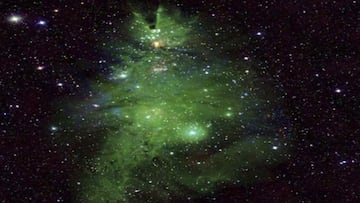What is the Christmas Tree Cluster that NASA has released, where is it located and how can I see it?
NASA has gotten into the holiday spirit by releasing a fun image of a star cluster shaped like a Christmas tree. Find out how you can see the formation.

NASA unveiled a fun gift on Christmas Eve. Demonstrating that the Christmas spirit can also exist in space, the agency released an image of a group of stars that has been nicknamed the Christmas Tree Cluster due to its shape and lights. The nebula’s outline is reminiscent of typical Christmas trees, and the “tree” even looks decorated thanks to the stars that look like ornaments. The green color of many stars in the collection makes it appear like pine.
The cluster, known to the world as NGC 2264 and located 2,500 light years away, is made up of very young stars, aged between one and five million years old. According to NASA, stars have a variety of sizes, with the smallest ones barely having a tenth of the mass of our Sun and the largest having seven times the mass of our solar system’s star.
READ ALSO: The best offers and discounts after Christmas
This certainly gets me into the holiday spirit – a new picture of the “Christmas Tree Cluster,” which is technically NGC 2264, a cluster of young stars. I hope you’re all enjoying this festive season and looking forward to Christmas! pic.twitter.com/oRyDPOftor
— Dr. Buzz Aldrin (@TheRealBuzz) December 20, 2023
“The optical data is represented by faint green lines and shapes, which create the branches and needles of the tree shape. The X-rays detected by Chandra appear as blue and white lights and resemble bright spots of light on the tree. The infrared data shows the stars in the foreground and background as bright white specks against the blackness of space,” according to NASA’s description of the composite image.
READ ALSO: When was Jesus of Nazareth born? Possible dates of birth according to the gospels
Where is NGC 2264 located?
Related stories
Situated in the constellation of Unicorn, this star cluster was discovered in 1784 by astronomer William Herschel, but it would not be until almost the 20th century when astronomer Leland Copeland baptized the conglomeration of heavenly bodies with its current name.
As a general rule, this stellar spectacle can be seen with the naked eye on a clear night, if you are away from the light pollution of large cities, with the Moon in the New Moon phase. The best time to see it is at the beginning of February.

